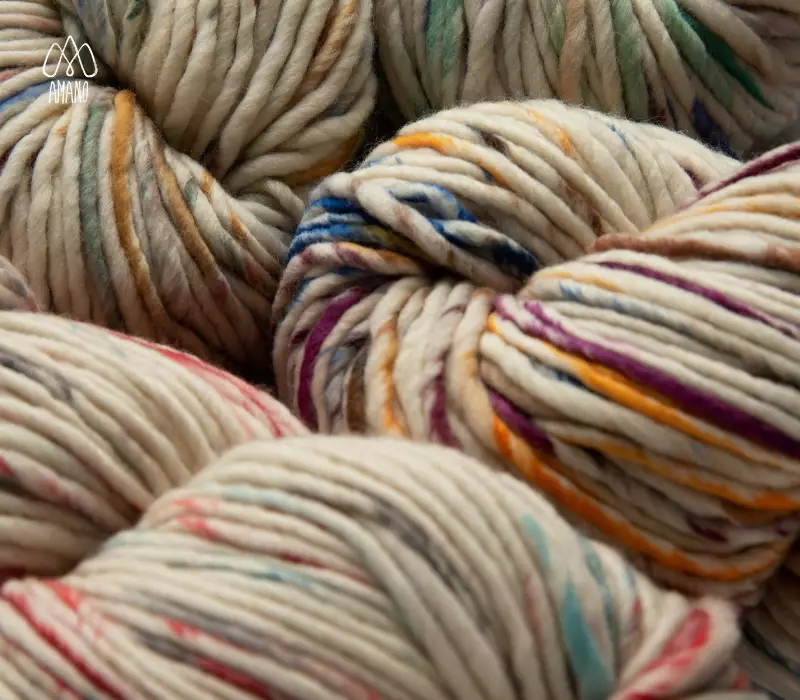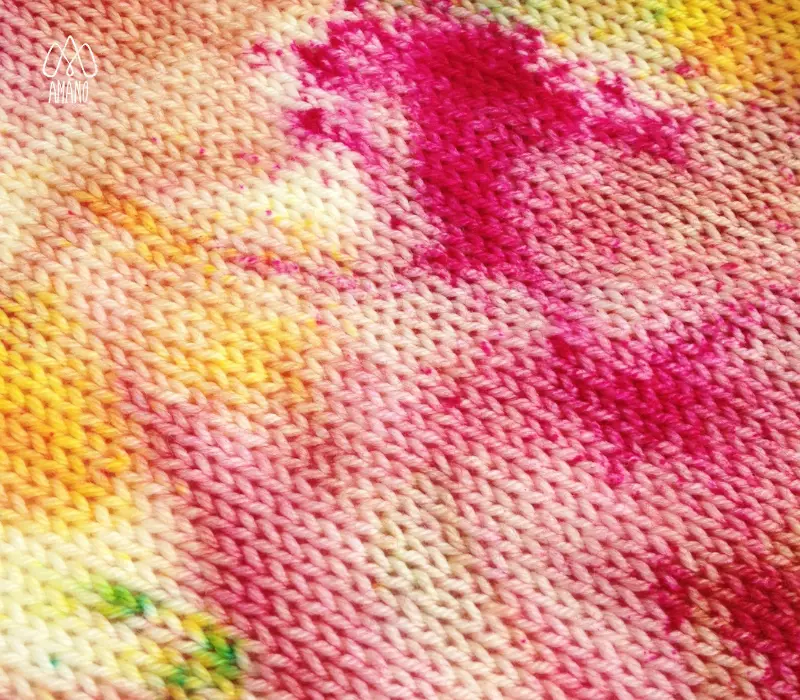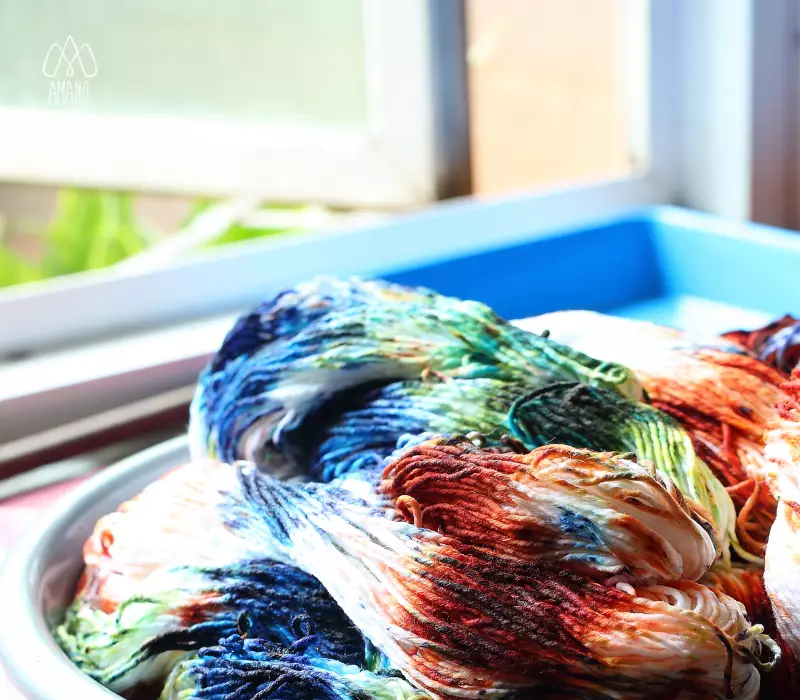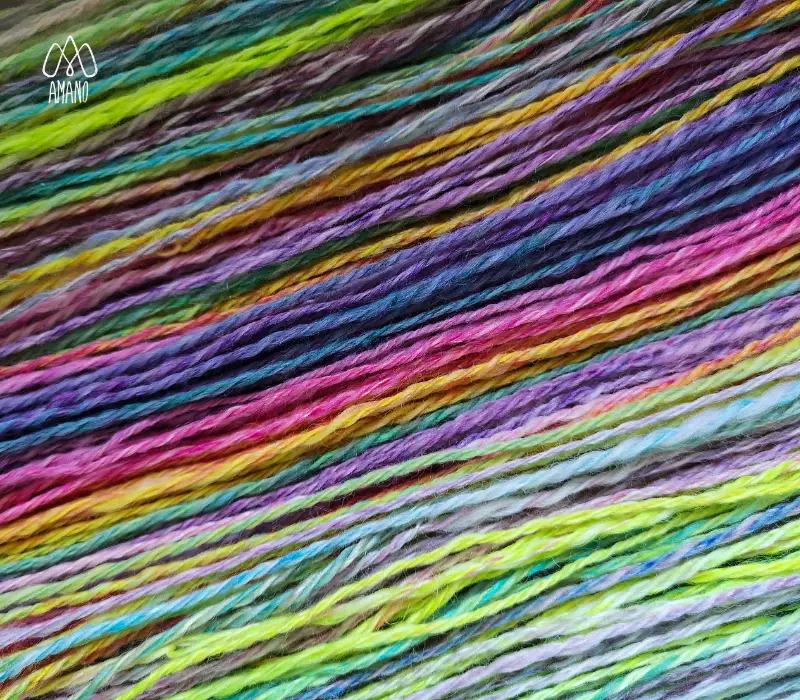Artisanal wool dyeing is a craft that combines tradition and creativity. For generations, people have used natural elements to add color to fibers, creating vibrant textiles that tell stories.

At AMANO, we honor these processes and work with natural fibers such as Baby Alpaca, Merino Wool, Silk, and Mohai, all ideal for artisanal dyeing techniques. While we’re inspired by traditional practices, our approach is rooted in the conscious application of certified, zero-impact dyes, which meet the highest environmental and quality standards.
Types of Wool for Dyeing
Each type of wool reacts differently to dyeing based on its fiber structure. Some absorb pigments more effectively, while others require specific mordants to fix the color. The main fibers used in artisanal dyeing include:
- Merino Wool: Extra soft, holds dye well without losing elasticity.
- Baby Alpaca: Requires careful handling to avoid felting.
- Organic Cotton: Delivers bright, even color results.
How Is Wool Dyed?
The artisanal dyeing process begins with carefully preparing the fiber. The wool must be washed to remove impurities and natural oils. It is then immersed in a warm water bath with mordants that help fix the dye. Traditionally, dyes can be plant- or mineral-based. Some commonly used ones include:
? Indig: Produces deep blue shades.
? Cochineal: Used to achieve vibrant reds.
? Walnut: Offers brown and earthy tones.
At AMANO, we do not use these natural pigments as our source of color. Instead, we apply carefully selected chemical dyes, free from heavy metals and certified internationally to guarantee safety and sustainability. Thanks to their advanced formulation, they provide a broad chromatic range without compromising the environment.

What Are the Dyeing Methods and How Many Are There?
There are several dyeing methods, each producing a different result:
- Loose fiber dyeing: Done before spinning in large vats, gives uniform color.
- Roving dyeing: Similar to the above, but applied to longer fiber strips for soft blends.
- Yarn dyeing: The yarn is dyed before weaving, often used in detailed fabrics.
- Warp beam dyeing: A large-scale technique used in industrial textiles.
In our case, we apply techniques like dyed-in-cone (devanado), where the yarn is colored in cone form, and also manual artistic techniques, in which colors are applied individually using brushes, special wraps, or localized dyeing—resulting in one-of-a-kind finishes rich in character.
What Are the Steps in the Wool Dyeing Process?
Wool dyeing follows key steps to ensure long-lasting color:
- Pre-washing – Removes oils and residues to enhance dye absorption.
- Preparing the dye bath – Water is heated and the appropriate mordant is added.
- Applying the dye – The wool is submerged or hand-treated with specific tools.
- Drying and setting – Wool is rinsed and dried slowly to stabilize the color.
We approach each stage with precision and care to achieve deep, stable, and vibrant hues.

What Are the Techniques for Dyeing?
Among the most common artisanal dyeing techniques are:
- Immersion dyeing: The wool is fully submerged in the dye bath.
- Resist dyeing: Certain areas are blocked off to create unique patterns.
- Slow fire dyeing: Prolonged heat deepens color tones.
To these, we add our own signature approach: handcrafted techniques using certified dyes, where design control meets artistic freedom.
What Is an Artisanal Dyeing Process?
Artisanal dyeing is defined by its manual, expressive, and detailed nature. While it has traditionally been associated with natural dyes, today it also refers to how the dye is applied, regardless of its origin.
At AMANO, we view artisanal dyeing as a way to create identity through color, respecting the fiber and the environment. We use certified dyes that ensure minimal environmental impact, full reliability, and a rich palette that enhances our fibers.

How Can Natural Fibers Be Lightened?
To achieve neutral shades and remove impurities, several gentle lightening methods can be used:
- Sun exposure: Natural light lightens the fiber over time.
- Baking soda and hydrogen peroxide: Used in eco-conscious bleaching.
- Repeated gentle washing: Softens tone without harming the fiber’s quality.
These methods prepare fibers to receive color without compromising their texture or softness.
Conclusion
Artisanal dyeing is a fascinating process that transforms natural fibers into unique pieces filled with history, technique, and emotion. At AMANO, we offer fibers such as Baby Alpaca, Merino Wool, Silk, and Mohair, and work with both industrial and handcrafted dyeing methods, applying certified dyes that respect both the fiber and the planet. If you’re looking for skeins and balls ready to become color, our collection guarantees exceptional textures and consistent results in every project.



